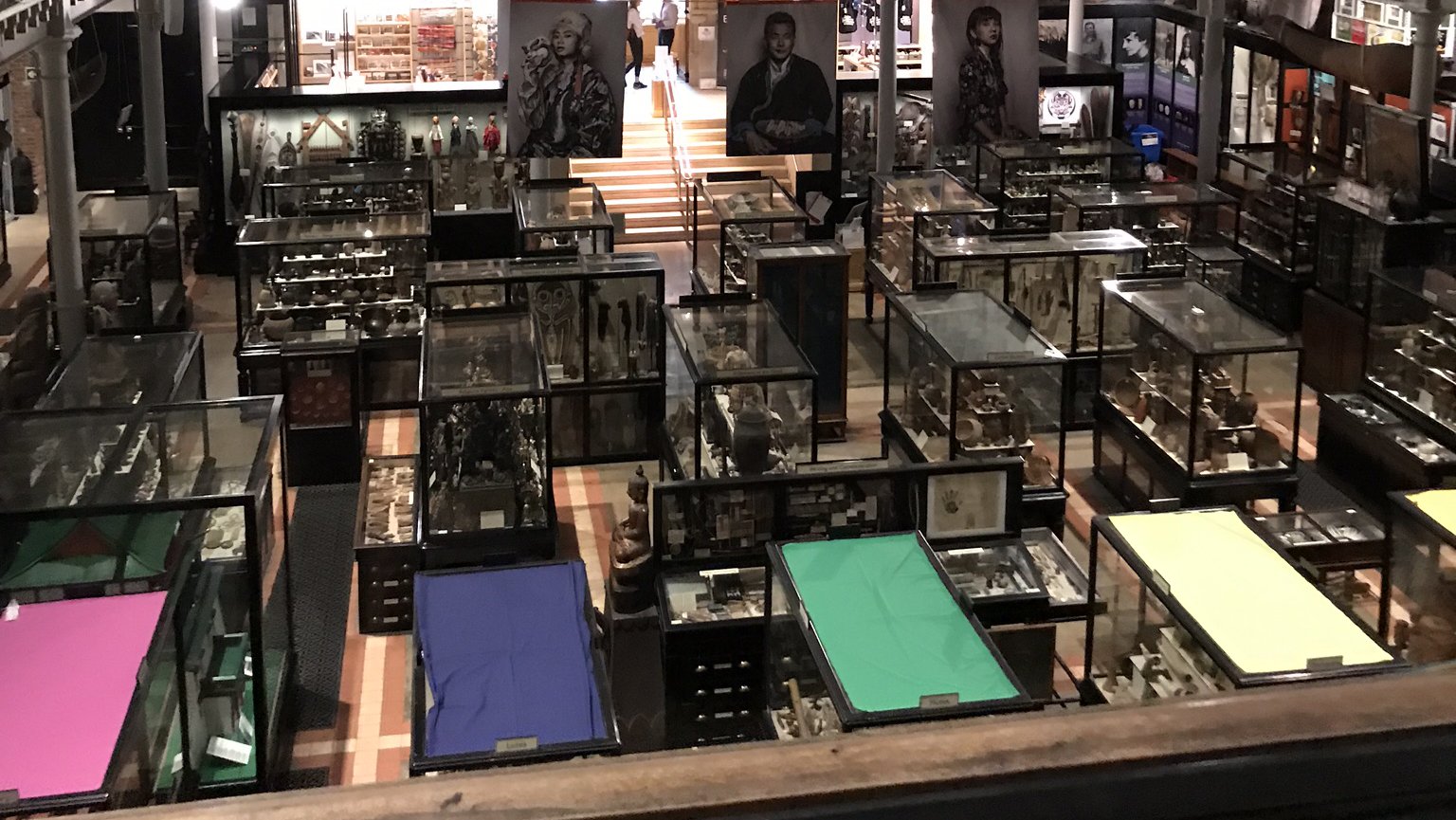

The Pitt Rivers Museum in Oxford, opened in 1887, is joined with the University of Oxford's Museum of Natural History. The building was made to be a temple to science.
The Pitt Rivers Museum collection, now more than 500,000 objects from across the globe, came from General Pitt Rivers. He was an influential man in the fields of archaeology and biological anthropology and donated his 27,000 piece collection to the University of Oxford in 1884. He made this gift on the conditions that a museum be built to house it, a lecturer be hired to teach on it, and the objects be displayed typographically. The exhibits are displayed not by place or time but by type of object. This is a unique approach and lets visitors compare cultural differences to common activities and human creations. Case themes range from currency to toys, weapons to textiles.
During the OPP session at Pitt Rivers we discussed the 'decolonization' of collections and how to interpret things with a cultural and global lens. How should the 21st century museum work with a collection that was created with 19th century ideals? Who should actually own these items? How did the objects come to reside in the collection, in England? How should interpretation research be done? Should the museum keep the racist and xenophobic labeling from centuries past?
It's hard to nail-down the right answers to these questions and the museum is taking baby steps to right some wrongs from the past. One step was to have the Open Palace Programme in for a brain storming session on label language and exhibit writing.
Most of the tiny, handwritten 18th/19th century labels in the museum showcase the objects not as culturally significant, but as curiosities of far away people. As a part of the "Labels Matter" project, the museum has decided to keep these original labels as reminders of the first staff's attitude toward the objects. Taking them away would be erasing or censoring part of history; White-washing history does nothing for our future. Instead, the museum now creates new labels to interpret the objects as well as the old labels- explaining why some language and vocabulary is no longer appropriate.
New labels may work to attach original/intended meaning of an object to it for visitors to learn about. Instead of displaying a figure as just a 'pretty statue from an exotic place' the interpretation can return it to being, say, an important religious item and attribute it to the correct culture.
More informative labeling is being added to correct provenance: "found after battle in chief's tent" is how one label reads on the second floor. Its a really watered down way of saying "we pillaged this village to the ground and looted this out of the tent of the chief we murdered". Many of the objects in the museum were looted by the British Army in the Victorian Era while they were waging imperialism around the world. The labeling is very passive and doesn't give agency to whoever took it from its original home in the first place.
The curatorial team of the museum is working to research provenance for the collection. If an item was bought, was it done ethically? If an item was stolen, who did it and when? Who was it taken from? These are all really important questions to ask and try to answer so the objects are given proper context.
Pitt Rivers is trying to move forward with repatriating objects back to the people they know were stolen from. Deaccessioning things from a museum collection is a long process so many times the first step is to loan objects back to the original culture and work from there. It's better to DO something and take a step forward first rather than waiting a long time to do it all at once.
The Masai have requested to get their stuff back but have offered to give contemporary pieces to the museum. This is incredibly gracious for them to do as they're asking for things that technically belong to them anyway. The contemporary pieces will be a way for the museum to interpret the current Masai culture with valid context and ownership.
The collection has thousands of ritual items, sacred objects, and human remains on display in crowded display cases. Having human remains and sacred objects in a collection comes with a lot of ethics questions.
Is this the best way to exhibit these items? probably not.
Should sacred items and human remains be on display at all? Probably not.
Is there a way to respectfully display someone's remains for thousands of people to stare at without that person's consent? Probably not.
Is the item worth being on display if it's not being interpreted correctly or given any context? Probably not.
I don't want to parade around photos of these objects, but you can catch a glimpse of them in the cover photo of this post. Under the "C" in 'Chloe Writes', those long dark objects are shrunken heads. If that was a loved one's head, would you be satisfied with its presentation? Does it look like they're placed there with respect and dignity? This museum is full of items like this and the museum staff is working on abiding by the original conditions of the item gifts while also bringing the exhibit into more dignified design; the two seem to butt heads.
There's a LOT of work to do for the Pitt Rivers collection, but the staff seems pretty dedicated to taking the steps to making it happen. They work with people from around the world to make sure they're getting their interpretation right.
Do you have thoughts on how to present these objects in a museum setting?
I think my time there with the OPP was very insightful. I don't have to do much ethnographic interpretation at Stan Hywet so I wasn't fully aware of how much goes into it.

Museum Professional. Traveler. Cat lover.